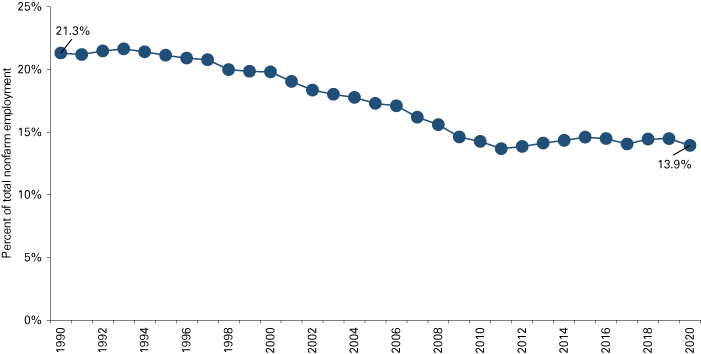Evansville forecast 2021

Professor of Economics and Provost, University of Southern Indiana
Sustained expansion of economic activity in the Evansville economy that spanned the past decade was dramatically disrupted in the first quarter of 2020 by the COVID-19 pandemic. Policymakers, employers and employees grappled with the challenging trade-offs between health concerns and economic activity. As result of efforts to combat the spread of the virus, there was a discernable slowdown in economic activity. The unemployment rate rose from 3.4% to 9.2% between January and June. A gradual slackening of restrictions aimed at curtailing community transmission during the third quarter resulted in a relatively rapid rebound in output and employment, highlighting the likelihood of a short-lived COVID-19-induced recession in the Evansville region.
Projects and announcements
During 2020, a number of projects and announcements of future fixed investments provide the basis for expected increases in employment and output in 2021. These include groundbreaking of a facility for a supplier of food packaging materials, the construction of a 100,000-square-foot shell building in an Industrial Park in Warrick County, the announcement of plans by a manufacturer of commercial and residential garage door parts and accessories to double its Evansville facility, and ongoing activity associated with the fixed investments that occurred in 2019.
Current indicators
Once all data are released for 2020, nominal personal income is estimated to have increased by 7.1% and real gross metro product is estimated to have increased by 2.2%. In 2021, Evansville metro area real output is forecast to increase by 9.2%, the number of jobs is projected to increase by around 500 jobs, and nominal personal income growth is forecast to decrease by 2%.
The unemployment rate in the Evansville metro increased from 3.4% in January 2020 to 5.1% in September 2020. There was also an increase in the national unemployment rate from 3.6% to 7.9% over the same time period. Job gains occurred primarily in the information, finance and insurance sector, as well as the professional, scientific and technical services sector. The primary activities experiencing jobs losses were wholesale and retail trade, the administrative, support, waste management and remediation services sector, construction, and manufacturing.
The manufacturing sector continues to be an important base to metro area household incomes and consumer spending activity even as the economy exhibits a long-term pattern of diversification away from manufacturing-industry dependence (see Figure 1).
Figure 1: Evansville metro manufacturing employment as a percent of total nonfarm employment

Note: 2020 data are for September.
Source: STATS Indiana, using U.S. Bureau of Labor Statistics and Indiana Department of Workforce Development data
As one of the most manufacturing-dependent metro areas in the nation, the Evansville economy was noticeably impacted by the COVID-19 pandemic. Since 2007, Evansville’s manufacturing workforce has fallen by 7.1% or about 3,200 workers, compared to an 8.6% reduction in Indiana’s manufacturing workforce over the same period. In 2020, manufacturing output continues to be a significant driver of economic activity, accounting for about 26% of the gross regional product in the Evansville regional economy. As Table 1 shows, the manufacturing sector accounts for 13.9% of employment in the Evansville metro.
Table 1: Manufacturing's percent of total employment, September 2020
| Evansville | Indiana | U.S. | |
|---|---|---|---|
| Manufacturing | 13.9% | 16.4% | 8.6% |
| Durables | 41.3% | 71.2% | 62.2% |
| Nondurables | 58.7% | 28.8% | 37.8% |
Source: STATS Indiana, using U.S. Bureau of Labor Statistics and
Indiana Department of Workforce Development data
Forecast
Given the proportion of output that is sold outside the metro area, the economic vitality in the Evansville area is linked to the strength of the broader economy. As employment and demand for locally produced goods continue to surpass pre-recession levels, employment and output are expected to increase in 2021.
A widening gap between the Evansville economy and the U.S. economy with regard to income growth trends over the past three decades highlights the importance of achieving higher rates of future output and employment growth. Strategies aimed at taking advantage of key industry clusters, such as advanced manufacturing and life sciences, continue to merit attention.



